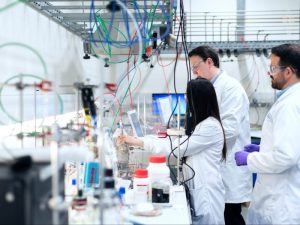Life Science Outlook Remains Strong: Cushman & Wakefield
Asking rents have increased 67 percent since 2015 and the construction pipeline is humming.
Despite concerns about the overall economy, despite inflation and higher interest rates, even despite a potential shortage of qualified labor, the life science sector “is poised for further growth and consistent demand in the years ahead,” according to a new report from Cushman & Wakefield.
The company’s October 2022 Life Sciences Outlook examines 15 metros in North America, along with Cambridge, London and Oxford in the United Kingdom, and concludes that in general, the industry remains vibrant and the fundamentals of its specialized real estate are strong.
The sector’s disproportionately high growth over the past seven years has driven U.S. asking rents up by an average of 67 percent since 2015, and inventory has grown by 29 percent across the multiple markets that Cushman & Wakefield Research tracks.
READ ALSO: Exploring Redevelopment Opportunities Within Life Sciences
Naturally, there are variations across those averages. While Seattle (27.2 percent) and San Diego (31.3 percent) saw double-digit rent growth from the end of 2021 through the second quarter, according to Cushman & Wakefield figures, three U.S. markets saw asking rents fall from year-end levels: Boston (-4.5 percent), the San Francisco Bay area (-3.3 percent) and New Jersey (-1.2 percent). Still, rents are higher than at year-end 2019.
Along with that, overall vacancies are low in most markets and below 10 percent in six U.S. markets: Los Angeles (1.8 percent), suburban Maryland (3.5 percent), Seattle (3.8 percent), Philadelphia (5 percent), San Diego (5.7 percent) and Boston (9.1 percent). And unlike the situation with office space, sublease space is not a significant factor in the vast majority of U.S. life science markets.
Spaces and people
In line with all this, development pipelines continue to be robust, the report states: “Current projects under construction in the U.S. are expected to add an additional 26.6 million square feet of lab space to existing inventory.”
About three-quarters of that, 19.9 million square feet, will be delivered this year or next. And about 60 percent of the space scheduled for completion this year is preleased.
Boston is in the lead for new space, with 13.9 million square feet, an amount that will increase the metro’s current lab space inventory by an estimated 43 percent.
The next two U.S. metros are well behind Boston; the next largest construction pipelines are in San Diego (3.7 million square feet) and the Bay Area (3.5 million square feet).
Though developers are being proactive about keeping the life science sector supplied with suitable workplaces, the industry’s workforce might be a different matter.
Cushman & Wakefield notes that U.S. life science employment doubled in size over the past 10 years, outrunning annual total employment growth by 6.6 percent vs. 1.2 percent, leading to a possible life science labor crunch. So far this year (through August), an estimated 137,707 unique life science jobs have been posted, a 28 percent increase from the same period last year.








You must be logged in to post a comment.